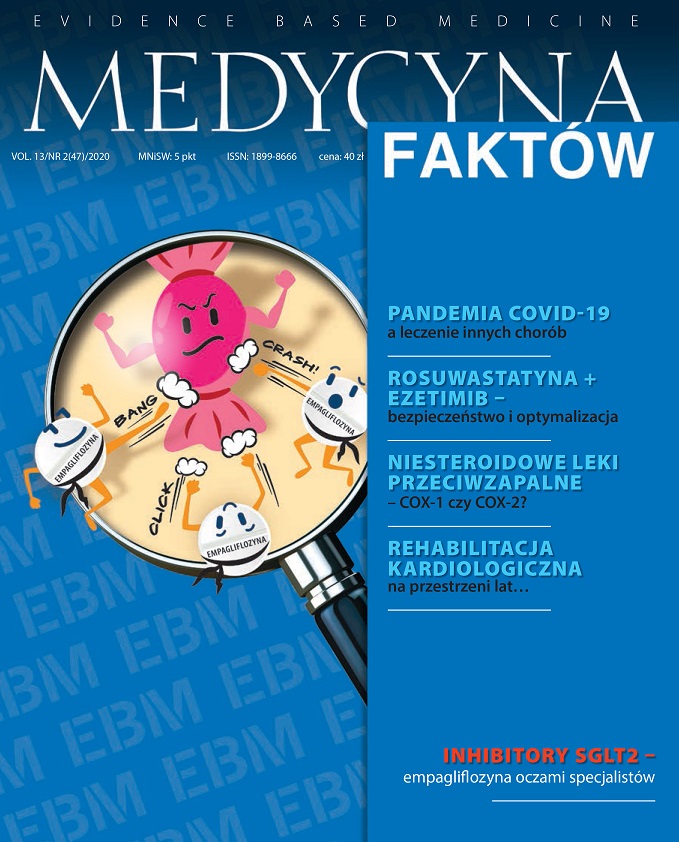Dziesięć powodów, dla których warto stosować meloksykam Artykuł przeglądowy
##plugins.themes.bootstrap3.article.main##
Abstrakt
Można stwierdzić, że meloksykam jest obecnie najbezpieczniejszym dla przewodu pokarmowego NLPZ dostępnym na naszym rynku, wskazanym w leczeniu bólu długofalowego towarzyszącego chorobom o podłożu zapalnym. Przewaga meloksykamu nad innymi lekami z tej grupy polega na tym, że słabiej zaburza syntezę ważnych dla funkcjonowania organizmu prostaglandyn, a tym samym jest znacznie bezpieczniejszy niż inne leki.
Meloksykam, działając hamująco na formę enzymu katalizującą procesy powstawania czynników prozapalnych, zmniejsza powstawanie bólu i obrzęków. Cechuje się dużą skutecznością w chorobach reumatycznych o podłożu zapalnym, a jednocześnie wywołuje znacznie mniej działań niepożądanych ze strony przewodu pokarmowego niż klasyczne, nieselektywne leki.
##plugins.themes.bootstrap3.article.details##
Copyright © by Medical Education. All rights reserved.
Bibliografia
2. Chisholm-Burns MA, Schwinghammer TL, Malone PM et al. Pharmacotherapy Principles & Practice. McGraw Hill Education, New York 2019.
3. Guan Z, Hellman J, Schumacher M. Contemporary views on inflammatory pain mechanisms: TRPing over innate and microglial pathways [version 1; referees: 3 approved]. F1000 Res. 2016 5(F1000 Faculty Rev): 2425.
4. Celiński K, Chęć P, Chęć M. Gastrotoksyczność niesteroidowych leków przeciwzapalnych. eReumatologia news. 2014: 1.
5. Fan M, Liu J, Zhao B et al. Indirect comparison of NSAIDs for ankylosing spondylitis: Network meta-analysis of randomized, double-blinded, controlled trials. Exp Ther Med. 2020; 19(4): 3031-41.
6. Vidal L, Kneer W, Baturone M et al. Meloxicam in acute episodes of soft tissue rheumatism of the shoulder. Inflamm Res. 2001; 50(suppl 1): 24-9.
7. Filipczak-Bryniarska I. Zastosowanie preferencyjnych niesteroidowych leków przeciwzapalnych i preparatów działających miejscowo w leczeniu dorsalgii. Medycyna Praktyczna. 2013.
8. Wordliczek J, Dobrogowski J (ed). Leczenie bólu. Wydawnictwo Lekarskie PZWL, Warszawa 2007: 36.
9. Goei HS, Lund B, Distel MR et al. A double-blind, randomized trial to compare meloxicam 15 mg with diclofenac 100 mg in the treatment of osteoarthritis of the knee. Osteoarthr Cartilage. 1997; 5: 283-8.
10. Hawkey C, Kahan A, Steinbrück K et al. Gastrointestinal tolerability of meloxicam compared to diclofenac in osteoarthritis patients. International MELISSA Study Group. Meloxicam Large-scale International Study Safety Assessment. Br J Rheumatol. 1998; 37(9): 937-45.
11. Furst DE, Kolba KS, Fleischmann R et al. Dose response and safety study of meloxicam up to 22.5 mg daily in rheumatoid arthritis: a 12 week multicenter, double blind, dose response study versus placebo and diclofenac. J Rheumatol. 2002; 29: 436-46.
12. Distel MC, Bluhmki E, Fries J. Safety of meloxicam: a global analysis of clinical trials. Br J Rheumatol. 1996; 35(suppl 1): 68-77.
13. Trelle S, Reichenbach S, Wandel S et al. Cardiovascular safety of non-steroidal anti-inflammatory drugs: network meta-analysis. BMJ. 2011; 342: c7086. http://doi.org/10.1136/bmj.c7086.
14. Singh GS, Garnier P, Hwang E et al. Meloxicam does not increase the risk of cardiovascular adverse events compared to other NSAIDs: results from the IMPROVE trial, a multi-center, randomized parallel-group, open label study of 1309 patients in a manager case setting. EULAR Annual Congress of Rheumatology, Stockholm. Sweden, THU0259 (Abstract).
15. Blot L, Marcelis A, Devogelaer JP. Effects of diclofenac, aceclofenac and meloxicam on the metabolism of proteoglycans and hyaluronan in osteoarthritic human cartilage. Brit J Pharmacol. 2000; 131: 1413-21.
16. Misiołek H, Copik M. Meloksikam ODT – nowe podejście do starego problemu. Medycyna i Życie. 2012; 20: 5-16.
17. Dziewulski M. Zastosowanie meloksikamu w leczeniu reumatoidalnego zapalenia stawów. Medycyna Rodzinna. 2004; 3: 109-12.
18. Macintyre PE, Scott DA, Schug SA et al. Acute Pain Management: Scientific Evidence. ANZCA. 2010.
19. Altman R, Luciardi HL, Muntaner J et al. Efficacy assessment of meloxicam, a preferential cyclooxygenase-2 inhibitor, in acute coronary syndromes without ST-segment elevation: the Nonsteroidal Anti-Inflammatory Drugs in Unstable Angina Treatment-2 (NUT-2) pilot study. Circulation. 2002; 106: 191-5.
20. Dreiser RL. Oral meloxicam is effective in acute sciatica: two randomised, double-blind trials versus placebo or diclofenac. Inflamm Res. 2001; 50(suppl 1): S17-23.
21. Valat JP, Accardo S, Reginster J et al. A comparison of the efficacy and tolerability of meloxicam and diclofenac in the treatment of patients with osteoarthritis of the lumbar spine. Inflamm Res. 2001; 50: 30-4.
22. Vidal L, Kneer W, Baturone M et al. Meloxicam in acute episodes of soft tissue rheumatism of the shoulder. Inflamm Res. 2001; 50(suppl 1): 24-9.
23. Khalil NY, Aldosari KF. Meloxicam. Profiles Drug Subst. Excip Relat Methodol. 2020; 45: 159-97. http://doi.org/10.1016/bs.podrm.2019.10.006.
24. Liam K, David C, Devinder A et al. Cyclooxygenase-2 inhibitors delay relapse and reduce Prostate Specific Antigen (PSA) velocity in patients treated with radiotherapy for nonmetastatic prostate cancer: a pilot study. Prostate Int. 2020; 8: 34-40.
25. Filipczak-Bryniarska I. Zastosowanie preferencyjnych niesteroidowych leków przeciwzapalnych i preparatów działających miejscowo w leczeniu dorsalgii. Medycyna Praktyczna. 2013.
26. Gates BJ, Nguyen TT, Setter SM et al. Meloxicam: a reappraisal of pharmacokinetics, efficacy and safety. Expert Opin Pharmacother. 2005; 6: 2117-40.
